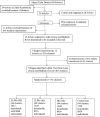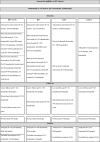Long-lasting insecticidal nets and indoor residual spraying may not be sufficient to eliminate malaria in a low malaria incidence area: results from a cluster randomized controlled trial in Ethiopia
- PMID: 30999957
- PMCID: PMC6471954
- DOI: 10.1186/s12936-019-2775-1
Long-lasting insecticidal nets and indoor residual spraying may not be sufficient to eliminate malaria in a low malaria incidence area: results from a cluster randomized controlled trial in Ethiopia
Abstract
Background: Conflicting results exist on the added benefit of combining long-lasting insecticidal nets (LLINs) with indoor residual spraying (IRS) to control malaria infection. The main study objective was to evaluate whether the combined use of LLINs and IRS with propoxur provides additional protection against Plasmodium falciparum and/or Plasmodium vivax among all age groups compared to LLINs or IRS alone.
Methods: This cluster-randomized, controlled trial was conducted in the Rift Valley area of Ethiopia from September 2014 to January 2017 (121 weeks); 44 villages were allocated to each of four study arms: LLIN + IRS, IRS, LLIN, and control. Each week, 6071 households with 34,548 persons were surveyed by active and passive case detection for clinical malaria. Primary endpoints were the incidence of clinical malaria and anaemia prevalence.
Results: During the study, 1183 malaria episodes were identified, of which 55.1% were P. falciparum and 25.3% were P. vivax, and 19.6% were mixed infections of P. falciparum and P. vivax. The overall malaria incidence was 16.5 per 1000 person-years of observation time (PYO), and similar in the four arms with 17.2 per 1000 PYO in the LLIN + IRS arm, 16.1 in LLIN, 17.0 in IRS, and 15.6 in the control arm. There was no significant difference in risk of anaemia among the trial arms.
Conclusions: The clinical malaria incidence and anaemia prevalence were similar in the four study groups. In areas with low malaria incidence, using LLINs and IRS in combination or alone may not eliminate malaria. Complementary interventions that reduce residual malaria transmission should be explored in addition to LLINs and IRS to further reduce malaria transmission in such settings. Trial registration PACTR201411000882128 (08 September 2014).
Keywords: Anaemia; Cluster-randomized controlled trial; Ethiopia; Incidence; Indoor residual spraying; Long-lasting insecticidal nets; Malaria; Vector control.
Conflict of interest statement
The authors declare that they have no competing interests.
Figures
Similar articles
-
Impact of combining indoor residual spraying and long-lasting insecticidal nets on Anopheles arabiensis in Ethiopia: results from a cluster randomized controlled trial.Malar J. 2019 May 24;18(1):182. doi: 10.1186/s12936-019-2811-1. Malar J. 2019. PMID: 31126286 Free PMC article. Clinical Trial.
-
Efficacy of indoor residual spraying with dichlorodiphenyltrichloroethane against malaria in Gambian communities with high usage of long-lasting insecticidal mosquito nets: a cluster-randomised controlled trial.Lancet. 2015 Apr 11;385(9976):1436-46. doi: 10.1016/S0140-6736(14)61007-2. Epub 2014 Dec 9. Lancet. 2015. PMID: 25498847 Clinical Trial.
-
Combining long-lasting insecticidal nets and indoor residual spraying for malaria prevention in Ethiopia: study protocol for a cluster randomized controlled trial.Trials. 2016 Jan 12;17:20. doi: 10.1186/s13063-016-1154-2. Trials. 2016. PMID: 26758744 Free PMC article. Clinical Trial.
-
Reshaping the vector control strategy for malaria elimination in Ethiopia in the context of current evidence and new tools: opportunities and challenges.Malar J. 2018 Dec 5;17(1):454. doi: 10.1186/s12936-018-2607-8. Malar J. 2018. PMID: 30518395 Free PMC article. Review.
-
Current vector control challenges in the fight against malaria.Acta Trop. 2017 Oct;174:91-96. doi: 10.1016/j.actatropica.2017.06.028. Epub 2017 Jul 3. Acta Trop. 2017. PMID: 28684267 Review.
Cited by
-
Impact of combining indoor residual spraying and long-lasting insecticidal nets on Anopheles arabiensis in Ethiopia: results from a cluster randomized controlled trial.Malar J. 2019 May 24;18(1):182. doi: 10.1186/s12936-019-2811-1. Malar J. 2019. PMID: 31126286 Free PMC article. Clinical Trial.
-
Detection of temporal, spatial and spatiotemporal clustering of malaria incidence in northwest Ethiopia, 2012-2020.Sci Rep. 2022 Mar 7;12(1):3635. doi: 10.1038/s41598-022-07713-3. Sci Rep. 2022. PMID: 35256698 Free PMC article.
-
Emerging public health strategies in malaria control: innovations and implications.Ann Med Surg (Lond). 2024 Sep 20;86(11):6576-6584. doi: 10.1097/MS9.0000000000002578. eCollection 2024 Nov. Ann Med Surg (Lond). 2024. PMID: 39525724 Free PMC article. Review.
-
Quantifying and characterizing hourly human exposure to malaria vectors bites to address residual malaria transmission during dry and rainy seasons in rural Southwest Burkina Faso.BMC Public Health. 2021 Jan 30;21(1):251. doi: 10.1186/s12889-021-10304-y. BMC Public Health. 2021. PMID: 33516197 Free PMC article.
-
Effectiveness of indoor residual spraying on malaria control: a systematic review and meta-analysis.Infect Dis Poverty. 2022 Jul 23;11(1):83. doi: 10.1186/s40249-022-01005-8. Infect Dis Poverty. 2022. PMID: 35870946 Free PMC article.
References
-
- WHO . World malaria report 2013. Geneva: World Health Organization; 2013.
-
- Lengeler C. Insecticide-treated bed nets and curtains for preventing malaria. Cochrane Database Syst Rev. 2004:CD000363. - PubMed
-
- WHO . World malaria report 2014. Geneva: World Health Organization; 2014.
Publication types
MeSH terms
Substances
Grants and funding
LinkOut - more resources
Full Text Sources
Medical



